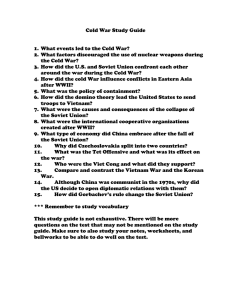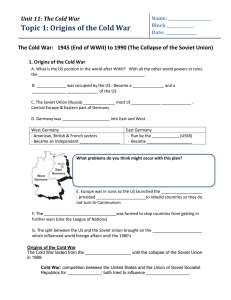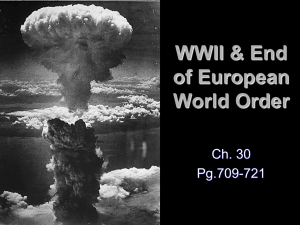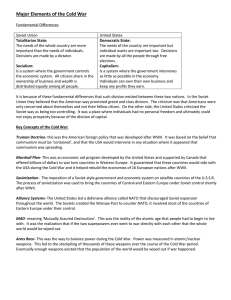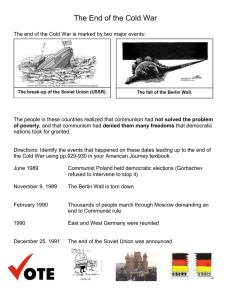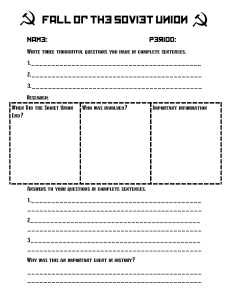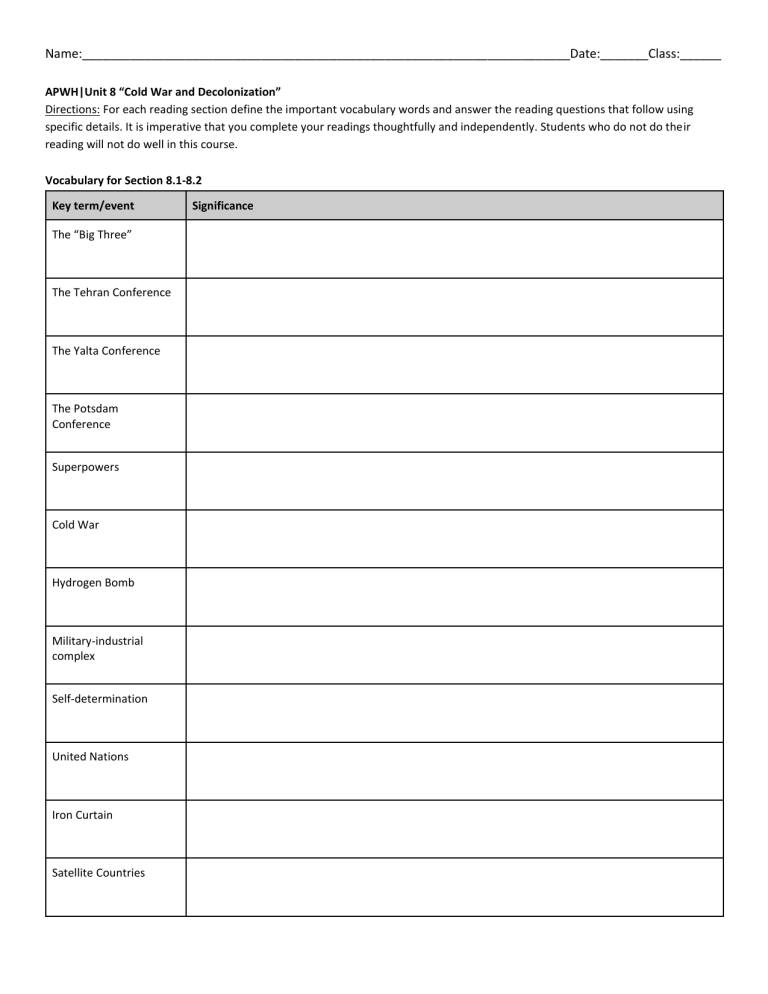
Name:_______________________________________________________________________Date:_______Class:______ APWH|Unit 8 “Cold War and Decolonization” Directions: For each reading section define the important vocabulary words and answer the reading questions that follow using specific details. It is imperative that you complete your readings thoughtfully and independently. Students who do not do their reading will not do well in this course. Vocabulary for Section 8.1-8.2 Key term/event The “Big Three” The Tehran Conference The Yalta Conference The Potsdam Conference Superpowers Cold War Hydrogen Bomb Military-industrial complex Self-determination United Nations Iron Curtain Satellite Countries Significance World Revolution Containment The Marshall Plan Space Race Section 8.1: Setting the Stage for the Cold War and Decolonization Objective Key Developments Explain the historical context of the Cold War after 1945. Bringing the War to an End Who was in the “Big Three”? There were three meetings after WWII between the “Big Three”. Describe what occurred in each of the meetings: Tehran Conference Yalta Conference The Potsdam Conference Explain how these meetings could “set the stage” for the Cold War. Shifting Balance of Power Why were Europe and Asia not leaders after WWII. What did a lot of countries “flee” to? Which major countries were devastated the most? What did countries like France and Great Britain lose during the war? What were 3 factors that positioned the United States to become one of the most powerful countries in the world in the aftermath of WWII? 1. 2. 3. Advances During the War What were some of the advancements in universities in the US that were invented during the wartime period? The Start of the Cold War There were obvious tensions between the Soviet Union and the US, but why would they not fight each other militarily? What did they do instead? What did they both create? Breakdown of Empires What did many of the colonies of major countries believe in after WWII and during the Cold War? Which two empires crumbled? What was the result of their crumbling? Foundations for dismantling of colonial empires: ● In the colonized world, movements for_____________________________ grew. Often they included both advocates for ____________________________ and proponents of ___________________________. ● World War II had so weakened _______________________ and ______________________, and the other colonial powers that they had fewer resources to resist independence. ● The Cold War between the US and the Society Union gave ___________________________________ two superpowers to recruit as supporters. Section 8.2: The Cold War Objective Key Developments Explain the causes and effects of the ideological struggle of the Cold War Cooperation Despite Conflict: The United Nations Despite ideological differences, what did ALL the Allies agree upon? Explain why the League of Nations failed. Rivalry in Economics and Politics What did the “Iron Curtain” represent? A. Capitalism and Communism Explain the key differences between the USA’s capitalism and the USSR’s communism. Capitalism Communism Explain the key differences between the USA's democracy and the USSR’s Authoritarianism. Democracy Authoritarianism Explain the similarities between the two superpowers. Conflicts in International Affairs What did each side want to do? What was the result? A. The USSR and Its Satellite Countries What did the USSR make the satellite countries they had do to compete with the USA? What did these actions allow the USSR to exploit? B. World Revolution What was the threat to the USSR according to them starting in 1918? What were some of the revolutions that the USSR supported? C. Containment What is the policy of containment? How did many people want to take the policy of containment “a step further”? D. Truman Doctrine What were the main ideas of the Truman Doctrine? Where specifically did the Truman Doctrine want to be instilled in? E. Marshall Plan What was the Marshall Plan? Why was the Marshall Plan created and what was it meant to stop? What did the Soviet Union also create in lieu of the Marshall Plan? What did it do? The Space Race and the Arms Race A. Space Race What was the first artificial satellite called? Who built it? What did it make the other superpower do? B. Mutual Assured Destruction (MAD) What did both countries figure out would happen if each of them set off their ICBM’s? The Non-Aligned Movement Where did many of the countries come from who wanted to stay out of the US-Soviet Cold War? Explain what they wanted. Who was a part of the Bandung Conference and what came out of it? Explain some of the challenges the Non-Aligned Movement faced: Non-Aligned Movement Examples Country Leader India Jawaharial Nehru Ghana Kwame Nkrumah Egypt Gamal Abdel Nasser Indonesia Sukarno Vocabulary for Section 8.3 Key term/event Proxy wars Berlin Airlift Berlin Wall North Atlantic Treaty Organization (NATO) Warsaw Pact Significance Role Communist bloc Domino Theory Anti Nuclear weapons movement Objective Key Developments Compare the ways in which the United States and the Soviet Union sought to maintain influence over the course of the Cold War. Introduction What were some of the examples of “proxy wars.” Allied Occupation of Germany *City of Berlin split after WWII Explain the significance of each event: Berlin Blockade Berlin Airlift NATO, The Warsaw Pact, and Other Alliances Two Germanys (Split between East and West) Berlin Wall Who was involved in NATO and what were the goals of it? What was the Soviet’s response to NATO? What was created? What is SEATO? Who was involved? What is CENTO? Who was involved? Proxy Wars A. Korean War How did the Korean War begin? What was the UN’s response and who did they support? How did the war end? B. Vietnam War What happened under US President Dwight D. Eisenhower? What happened under US President John F. Kennedy? What happened under US President Lyndon B. Johnson? What did he believe in also? C. The Bay of Pigs Crisis ● _______________________ and other Communist revolutionaries overthrew the Cuban dictator ______________________ in 1959. ● Castro set up a ___________________. After Cuba nationalized businesses, what was the US’s response? After the US’s response, what did the Cuban government do? What did JFK end up doing in response to a communist government set up 90 miles away from the coast of Florida? What effects did the Bay of Pigs have on US relations with Cuba? D. The Cuban Missile Crisis What did Nikita Khruschev do in response to the Bay of Pigs debacle? What was Khruschev’s rationale? What was set up during the Cuban Missile Crisis? Explain the significance of each: Test-Ban Treaty Antinuclear Weapon Movement What is it? Who was involved in the movement? Angola Contra War SBMCQ’s Answers 1. ___________________ Vocabulary for Section 8.4 & 8.5 Key term/event Significance Land reform Mao Zedong Communes Red Guards Theocracy The Muslim League Charles De Gaulle Viet Cong Ho Chi Minh Gamal Abdel Nasser Suez Crisis The “Quiet” Revolution Section 8.4: Spread of Communism after 1900 CE Objective Key Developments 2. _______________ 3. ___________________ Explain the causes and consequences of China’s adoption of communism. Introduction What did most socialists or communists seek to make more of? Most communist/socialists countries used _______________ to make this happen. Communism in China A. Great Leap Forward Describe how Mao Zedong and the communists rose to popularity in China. What were the goals of the Great Leap Forward? What were the results of the Great Leap Forward? B. Cultural Revolution What was Mao attempting to do with the Cultural Revolution? Explain the significance of the Red Guard and reeducation camps. C. Relations with the Soviets Circle one: What was the relationship like between China and the USSR? Hostile or Peaceful What events led to this relationship? Turmoil in Iran Both _____________________ and ____________________ fought for control of the area of Iran in early 20th century. A. Foreign Influence ● Early in WWII, the Iranian leader considered supporting _____________________ ● _______________ & ________________ were determined to not let that happen. ● They forced the leader to abdicate power to his young son, ____________________________ What ended up happening to the young Iranian leader? What did the Iranian people see the leader as? What was the US & British response to this event? B. Land Reform in the White Revolution Why was it called the White Revolution? What aspects were changed? The most important reform dealt with __________________________. C. The Iranian Revolution In 1979, what signified the revolution? After the toppling of the shah, what new government type was instituted? What religious text was used for all law? D. Guatemala ● A democratically elected government under _______________ in the Central American country of Guatemala began efforts at ______________________. ● Feeling threatened, the _____________________ lobbied the US government to remove the ____________________ ● In ________________, he was overthrown Land Reform in Asia and Africa A. Vietnam ● During WWII, Japan occupied Vietnam, which __________ still claimed as a colony ● At the end of the war in 1945, Vietnam ______________________from both Japan and France. ● A few people controlled most of the land ● ____________________ vowed to seize land from large landowners B. Ethiopia ● Ethiopia was originally under _____________ occupation ● __________________ returned to power under WWII. ● Ethiopia enjoyed economic success based off of ____________________ ● This led to ____________________ political and cultural reforms ● Selassie was unable to effectively implement ___________________ and his people started seeing him as a _____________________ puppet Who ended up rising to power? What did he order? And what did he declare the government of Ethiopia as now? C. India ● India was under ______________________ since 1858 ● Changed with the Independence movement leaded by ___________________ ● In 1947, India was partitioned, creating two states ________________________ & ________________________ Create a timeline of land reform in India and Pakistan. Section 8.5: Decolonization after 1900 Objective Key Developments Compare the processes by which various peoples pursued independence after 1900. Introduction There are basically two ways nations started to decolonize and gain independence, the first way is how India gained their independence, through _________________________. The second way is how Angola gained their independence and that is through ____________________________. Movements for Autonomy: India and Pakistan 1. The self-rule of India began in the 19th century under the Indian National Congress with its leader, Mohandas Gandhi. ● What were the independence tactics of the Indian National Congress? ● What did the Muslim League advocate for? ● When Britain failed to follow through on promises for more rights for Indians, what did Indian people do? Example? ● What resulted in the division between the Muslims and the Hindus of Indian? Decolonization in Ghana and Algeria Leaders and Methods of Independence (Armed Struggle or Political Negotiation) Major Events and Nationalist parties/organizations that assisted in Independence Legacy & Outcomes What occurred after independence? What were the successes and/or struggles of the nation? How have they dealt with the legacy of colonialism? Algeria (France) Ghana (Great Britain) Negotiated Independence in French West Africa 1. What countries were involved in French West Africa?. 2. Why was France reluctant to give up colonies in this area? 3. What resulted in the independence movements? Nationalism and Division in Vietnam ● Who was the Vietnamese Communist leader? ● What was the result of the Vietnamese war of independence? ● Who came into aid the French troops? ● Who were the Viet Cong? ● What resulted in the US taking over fighting in the Vietnam War? Struggles and Compromise in Egypt ● Explain who Nasser was and what his goals were. ● Explain the Suez Crisis and the results of it. Independence and Civil War in Nigeria ● What was the Biafran Civil War? ● What did the Igbos seek? ● What was the result of the Igbos’ secession? ● Explain what the government did to prevent tribalism. Canada and the “Silent Revolution” in Quebec ● Explain the historical context of colonial Quebec, Canda ● Explain the Quiet Revolution and what the results were of it. SBMCQ’s Answers 1. ___________________ 2. _______________ SBMCQ’s Answers 4. ___________________ 5. _______________ 3. __________________ 8.6 Vocabulary for Sections 8.6 & 8.7 Key term/event Zionist Movement Six-Day War Yom Kippur War Camp David Accords Palestinian Liberation Organization (PLO) Khmer Rouge Kashmir Sirimavo Bandaranaike Metropole Martin Luther King Jr. (MLK) Nelson Mandela Prague Spring Brezhnev Doctrine Significance Kent State University Irish Republican Army (IRA) Ulster Defence Association Osama Bin Laden September 11th (9/11) Section 8.6: Newly Independent States Objective Key Developments Explain how political changes in the period from c. 1900 to the present led to territorial, demographic, and nationalist developments. How did the Zionist movement contribute to the birth of Israel? Birth of Israel What did the Balfour Declaration propose for Jews? What did the Balfour Declaration intend for non-Jews? Describe how the events of 1948 led to Israel becoming its own country. Multiple Wars Which countries supported Israel? Which countries supported Palestine? What was the result of the Six-Day War? Israeli-Egyptian Peace Why did Palestine and several Arab states reject the Camp David Accords? What were the goals of the PLO? Ongoing Violence Who were the Fatahs? Who were the Hamas? What was Palestine angry about in regards to Israel? Cambodia Gain Independence and Survives Wars What did Khmer Rouge do in Cambodia? What were the results of the peace agreement between Cambodia and Vietnam in 1991? India and Pakistan Become Separate Countries In 1947, the British divided colonial India in 2 countries: ● India, which was mostly __________________ (religion) ● Pakistan, which was mostly __________________ (religion) How many people moved between India and Pakistan at this time? Describe Pakistan and India’s relationship after partition. Kashmir Conflict Describe the Kashmir Conflict Explain the economic changes and continuities resulting from the process of decolonization Women Gain Power in South Asia Country Sri Lanka India Female Leader Accomplishments Pakistan Tanzania Modernizes What did the Arusha Declaration of 1967 summarize? What were some of Nyerere’s successes as president of Tanzania? Emigration from Newer Countries to Older Ones What were some major “hot spots” in the world that became “metropole”? Why did citizens of newly independent countries emigrate to their former colonizing country (example: Algeria -> France)? Section 8.7:Global Resistance to Established Power Structures After 1900 Objective Key Developments Explain various reactions to existing power structures in the period after 1900. Nonviolent Resistance as a Path to Change Leader Mohandas Gandhi Martin Luther King Jr. Nelson Mandela Country they changed How were they NON-Violent and how did that lead to change? Challenges to Soviet Power in Eastern Europe Poland Describe Wladyslaw Gomulka’s time as secretary of the Polish Communist Party. Hungary Describe Imre Nagy’’s time as political leader of Hungary. Czechoslovakia What demands of the people did Alexander Dubcek give in to? What was the Brezhnev Doctrine used for? 1968: The Year of Revolt List the countries that revolted in 1968 What caused many of the protests and revolts in 1968? France Describe the student movement in France in 1968. The United States What were people protesting for in the United States in 1968? An Age of Terrorism What replaced most of the large-scale open-conflict (war) between sovereign states after the Cold War? Conflict in Northern Ireland What denomination of Chrsitianity were people in most of Ireland? What denomination of Chrsitianity were people in Northern Ireland? What terrorist acts did some members of the IRA commit in London? Separatists in Spain Who were Basque Homeland and Freedom (ETA)? What was ETA’s goal? Peru’s Shining Path What was the Shining Path’s goal? Islamic Terrorism What are the names of the Islamic terrorist groups in the section? Which Islamic terrorist group was the the deadliest? How were they funded? Terrorism in the United States Aside from 9/11, who was responsible for the majority of the terrorist attacks in the United States? Response of Militarized States The Franco Dictatorship in Spain Why did the United States support Francisco Franco in spite of his human rights violations? What did Spain do when Franco died? Intensified Conflict In Uganda Under Idi Amin Describe Idi Amin’s time as president of Uganda? The Military-Industrial Complex Conflicts around the world intensified because of ___________________ and _________________. Describe a military-industrial complex Vocabulary for 8.8 & 8.9 Key term/event Significance Ronald Reagan Mikhail Gorbachev détente Strategic Arms Limitation Treaty (SALT) Strategic Defense Initiative (SDI) Perestroika Glasnost Intermediate-Range Nuclear Forces Treaty (INF) Section 8.8: End of the Cold War Objective Key Developments Explain the causes of the end of the Cold War. The Final Decades of the Cold War What was the fundamental disagreement between the United States and the Soviet Union? Détente and a Colder War Define détente. What did Richard Nixon do that represented détente in Soviet Union and China Describe the challenges the USSR faced in the 1960’s and 1970’s. What issues was the United States having in the 1960’s and 1970’s What actions ended détente? Soviet-Afghan War How did the Soviet-Afghan war contribute to the fall of the Soveit Union? Reagan and Gorbachev What did Reagan do in the 1980's to upset the Soviet Union? What was the purpose of the Strategic Defense Initiative? How did Soviet Union respond to the SDI? The Thaw What is perestroika? What is glasnost? What did the Intermediate-Range Nuclear Forces Treaty (INF) aim to accomplish? The End of the Soviet Union Gorbachev reduced the Soviet Union’s involvement in their satellite states. What did that lead to in Eastern Europe and East and West Germany? The Spread of Reforms What did Lithuania, Georgia, and other Soviet republics do as a result of the democratic reforms sweeping through Eastern Europe? What happened in 1991 in regards to the Soviet Union and the Cold War? New Challenges Explain the challenges that occurred as a result of the fall of the Soviet Union and end of the Cold War. So, what caused the end of the Cold War
